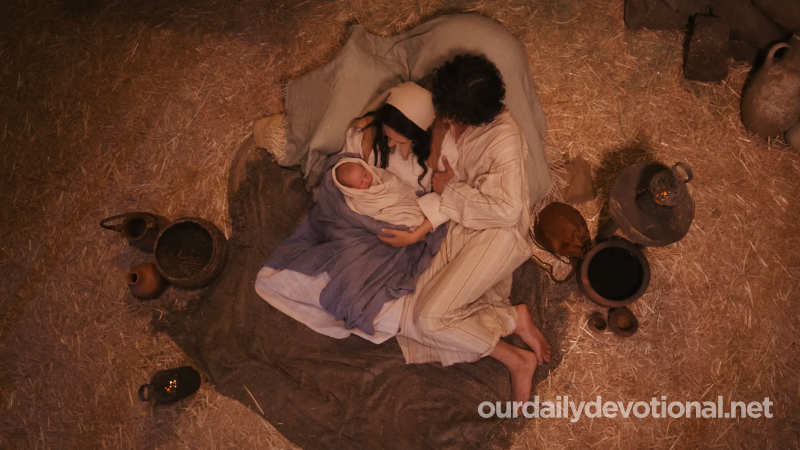Poetry, one of the oldest forms of literature, frequently accompanied dance, giving it rhythm (Ex. 15:20, 21). A young people express their emotions through contrasting images, which their vivid imagination draws from nature.
The poetry of the ancient Hebrews presents these circumstances. Sarah's words about her newborn have a poetic form (Gen. 21:6, 7). Jacob, before dying, gathers his twelve sons, and pronounces upon each of them a blessing, both prophetic and poetic (Gen. 49).
Full of gratitude toward the Lord, who had thrown Pharaoh's entire army into the sea, and realizing that the Canaanites would be filled with terror, Moses expressed his feelings and those of the Israelites in a simple and admirable song (Ex. 15 :1-19), to which Mary, his sister, added hers (Ex. 15:20, 21).
Ancient Hebrew poetry does not rely on rhyme. There are some poems that present certain caesuras, but this is the exception. Assonance, alliteration, and rhyme, although common in Eastern poetry, are rarely found among the Hebrews.
They do not use a regular succession of stressed and unstressed syllables either. But an intense sense of rhythm caused poets to produce verses containing the same number of words, or at least tonic accents.
The verses and the meaning end simultaneously (except in exceptional cases, as in Ps. 92, where verse 14 continues into verse 15). The essential character of Hebrew poetry is parallelism, so that the second verse is in one way or another an echo of the preceding one.
This particularity has the immense advantage that it persists after translation, which does not happen with rhyme. Robert Lowth was the first to draw attention to this particularity, in 1753, and highlighted three types of parallelism: the synonymous, the synthetic and the antithetical. There are also other varieties.
(a) Synonymous parallelism. The thought of the first verse is repeated in other words in the second verse (e.g. Gen. 4:23): Ada and Zilah, hear my voice; Women of Lamech, hear my saying: The stanza: That a man I will kill for my wound, And a young man for my blow, offers the same synonymous parallelism as the first.
Lamech had not killed two people (in the original it is in the past tense) but only one. Knowledge of this synonymous parallelism allows us to clarify certain passages that are ambiguous at first sight.
For example, Ps. 22:20: Deliver my soul from the sword, My only soul from the power of the dog. The only one is, in effect, the soul of the psalmist, his life (in fact, modern revisions of the Reina Valera say "my life").
(b) Parallelism by ascending gradation. The second line emits a new idea, more or less closely related to the first, e.g. e.g., Jb. 3:17: There the wicked stop disturbing. And there those with exhausted strength rest.
(c) Synthetic parallelism. The first part serves as a basis for the idea introduced by the second, p. e.g., Ps. 25:12: Who is the man that fears the Lord?
He will teach him the path he must choose. Pr. 26: 4: Never answer a fool according to his foolishness, Lest you also be like him Ps. 24: 9: Lift up your heads, O doors, And lift up yourselves, eternal doors, And the eternal door will enter King of glory.
(d) Emphatic parallelism. Characteristic terms are repeated, to round out the thought, e.g. e.g., Ps. 29:5: The voice of the Lord breaks the cedars; The Lord broke the cedars of Lebanon. Ps. 121:3, 4: Your foot will not make it slippery, Nor will he who keeps you fall asleep. Behold, He who keeps Israel will neither slumber nor sleep.
(e) Antithetical parallelism. The second thought makes the first re-emerge, by antithesis; p. e.g., Pr. 10: 1: A wise son makes his father happy, But a fool brings sorrow to his mother. Mt. 8:20: Foxes have holes, and birds of the air have nests; But the Son of Man has nowhere to lay his head.
(f) Comparative parallelism. A similarity, taken from a familiar domain, clarifies the thought; p. e.g., Ps. 42:1: As the deer pants for the streams of water, So pants my soul for you, O God.
Parallelism generally uses couplets (two verses that together give a complete meaning), but sometimes tristics are used (see the previous examples). Parallelisms are also found extended to the stanzas of the fourth or fifth verse (Ps. 1:3; 27:4, 9; 37:7, 14, 20, 25, 28, 34, 40).
The stanza does not constitute an essential element of Hebrew poetry, however, it is found in Ps. 42 and 43, which originally formed a single poem, divided into equal parts by a proverb.
Psalm 46 is composed of three groups of three verses each; each of them is followed by a pause (Selah), and each of the two groups is followed by a proverb.
There are also alphabetical psalms, in which each verse begins, in Hebrew, with a letter of the alphabet, and in which the psalmist observes, with greater or lesser rigor, the alphabetical order (Ps. 25; 34; 37).
The twenty-two successive letters of the alphabet are found in the twenty-two stanzas of Ps. 119; Each stanza has eight verses and each of them begins with the letter attributed to the stanza.
The book of Lamentations of Jeremiah is composed in a similar way (See LAMENTATIONS) Poetic art is generally epic, dramatic, lyrical or didactic, but in the Bible neither epics nor dramas are found in verse, the Book of Job is, however, semi-dramatic, the action appears only in the prologue and epilogue.
The rest of the book is made up of the alternating speeches of Job and his friends. See also SONG OF SONGS. Most biblical poems are lyrical. After the exodus, lyricism appears in every period of Israel's literary history.
The God-given deliverance was celebrated with triumphant odes: the song of Moses, singing the passage of the Red Sea; the song of Deborah; psalms of the repentant imploring mercy or expressing the joy of forgiveness (Ps. 32; 51), cries of anguish, serene affirmations of faith, thanksgiving for help obtained (Ps. 38: 3; 23; Hab. 3; 1 S. 2:1-10; Is. 38:10-20; Lk. 1:46-55), psalms that announce the coming of the Redeemer and His kingdom (Ps. 2; 45; 72), elegies such as that of David by Saul and Jonathan (2 Sam. 1:17-27), of the sons of Korah over Judah (Ps. 44); lamentations (Ps. 60; 74).
In the book of the prophet Habakkuk (Hab. 3:17-19) there is a sublime passage in which the faith that contemplates God beyond the circumstances of this life is evident, and that expresses the believer's confidence in him. Sovereign God and Savior, who leads his people through the difficulties of their pilgrimage: Although the fig tree does not bloom, Nor are there fruits on the vines, Although the produce of the olive tree is missing, And the fields do not provide maintenance, And the sheep are removed from the sheepfold, and there are no cows in the corrals; Yet I will rejoice in the Lord, And I will rejoice in the God of my salvation.
The Lord God is my strength, who makes my feet like deer's feet, and makes me walk on my heights.
Meaning of POETRY
Poetry, one of the oldest forms of literature, frequently accompanied dance, giving it rhythm (Ex. 15:20, 21). A young people express their emotions through contrasting images, which their vivid imagination draws from nature.







